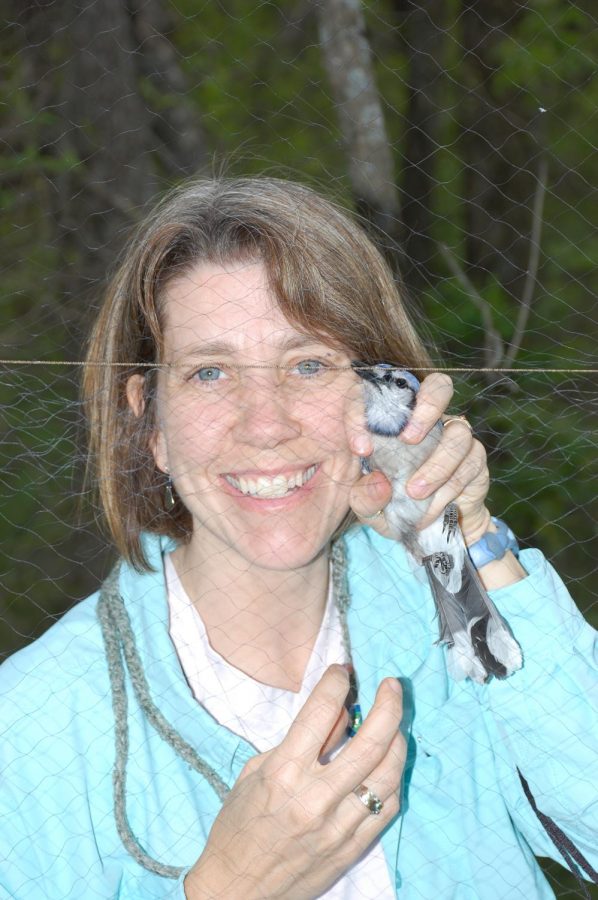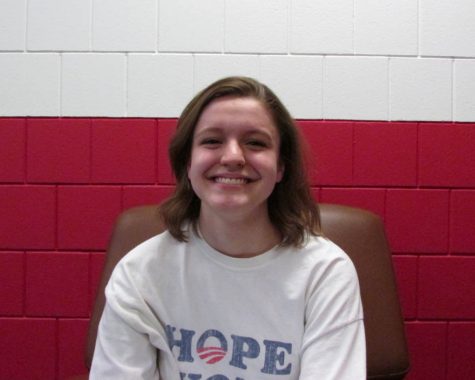Joanna Eckles pursues love of birds as she battles for their ecological safety
February 1, 2018
Having specifically asked for her cup of steaming water in a white ceramic mug, Joanna Eckles carefully balances her muffin and beverage in hand. Taking a seat, she dropped her bag of green tea into the water to steep, and began to pick apart her blueberry muffin while starting at the beginning of her laundry list of achievements.
“I was interested in birds from when I was about eight years old, so about second grade. We started getting interested just in the bird in our backyard and that was really mostly driven by me, I just was interested. . . That natural curiosity of a kid led me to just memorize the bird book,” Eckles says of her longtime passion for ornithology.
Joanna, a conservation biologist with a degree from Cornell, specializes in the interactions between birds and human development, specifically glass. Founding multiple programs for the Audubon Society, including one leading her to work on a more bird-friendly glass option for the US Bank Stadium, she has become a top advocate in the Twin Cities and even the entire country on urban planning designed to aid the local bird populations.
“I don’t think I memorized the bird book even intentionally, it was just as I paged through. You know those books you have as a kid where you just know every page, because you just looked at it. Some kids learned about dinosaurs or whales, or dolphins, or whatever. That was just it.” Joanna further explained.
Growing Up
Her love of birds has rubbed off on the rest of her family, both young and old, with one rather noticeable exception.
“My parents did end up getting into it and it ended up being a major interest that they had too, even after I left. They bought a property where they really focused on attracting birds. My mom ended up doing a lot of citizen science work later when we were gone, she would help with surveys of different kinds.” Joanna added.
“I know she always said nature’s important, and she’s always kind of stressed, ‘You should go outside, and pay attention to what’s going on.’ I think it’s just really cool, because I know a lot more about nature and birds and stuff than most people, who have absolutely no idea,” junior Torianna Eckles, her daughter, said. “I’ll be more aware of taking care of the environment than some people. That’s something that I really value.”
“My sister wasn’t really into it. She was older than me, a couple years, so we’d go on these camping trips and we’d be all interested in the birds and then she’s – ‘Another bird? Why are we stopping for another bird?’ You can picture that, right?” Joanna laughed.
As time progressed, the passion seemed to quiet ostensibly, though her inner love of birds remained.
“I bird-watched as much as I could in high school, but it just wasn’t very cool. It was not something people knew about me, I don’t think. But when it came time to decide for college what I wanted to focus on: in those days we read college brochures, we had books that listed majors. So the majors that attracted me were zoology and ornithology,” Joanna said.
Her focus ended up Natural Resources. Through her love of birds, she had learned about the trees, plants, and other factors that went into making their habitats. To her, it seemed a natural fit as something she had grown to care about in her research. Her focus became the bigger systems while at Cornell, an experience which she loved. Something which continued to bring her back to her love of nature were research internships over the summer, specifically her summer on the beach.
“The cool thing about [beach nesting birds] is that they are so faithful to their nest – and they nest in just literally on the beach in a little depression where they lay their eggs, so they’re super vulnerable to people walking, dogs running, vehicles who drive on there, that’s why they’re at risk – but the cool thing is once you find their nest, which is just by watching them, basically, and being super observant, you can set a trap right over their nest. The parents are so faithful to that nest and protecting those eggs that they will walk around the trap ‘til they find the little one-way door and then sit on their eggs.” Joanna explained.
Beginning Work
Following opportunities such as these, she migrated to the Minnesota Zoo to work on their famous World of Birds Show.
“The idea was that you would teach them to do something they would do normally, such as a particular way of flying or handling prey that’s unique to them. Then you would train them to do that in a place where people could watch it, and not just wait – like, maybe it happens. So that was super fun,” Joanna explained. “I left the Zoo when [Jayger] was a baby.”
Mother of Jayger Eckles, Stillwater graduate as of 2017, and Torianna Eckles, current junior, Joanna spent her years following her work at the Zoo bouncing between nonprofits focused on conservation – and mainly on birds. The World Parrot Trust (WPT) for 16 years, as an editor of their newsletter – editing “every caption, every pullquote. Since it was such a small organization, I ended up doing a lot of the layout, in InDesign.”
“I’d edit [features] so that it was the right tone for a magazine like this. Sometime, depending on the person’s style, you’re doing a ton of work with them . . . A lot of scientists write for science. And they’ll always start with, ‘The whatever – the Cape Parrot, who lived in the high montane regions of the whatever-’ And you’d have to go ‘Okay well, that can go in a sidebar; that’s not how we want to start. We want to start with: what’s your story?’’ Joanna said of her time at the WPT. “So it’s a lot of coaching them in getting their stories out.”
Over her years in the field, she cites a vast difference between the birdwatching community like her parents, and bird scientists, finding birdwatchers to be more intense. Through online communities, intense fans can track bird, and go out at try to see some of the same species as their peers.
“Just in that sort of birdwatching population, there are some really interesting people that will get obsessed with listing. So they’ll start on the first day of the year anf count every bird they see in Minnesota for that year. And they’ll have a life list, so every bird they’ve seen all over the world, and sometimes down to counting lists or yard lists or work lists. It’s just new ways of making it exciting and fun,” Joanna stated.
“In our park behind our house here in Stillwater, I found a rare duck. So I reported it on these apps to report sightings. And there’s people who are watching for any rarities, and this bird, you enter it and it says – ‘Are you sure? Because this bird shouldn’t be here,’ and you say ‘Yes,’ and upload a photo. And the next morning, my park was inundated with birdwatchers. It was so funny, because I knew about this, I’ve been chasing, trying to find birds that people have reported, but I’ve never been one that had found it.” Joanna added. “That gave me whole new understanding of that personality type, because some of them showed me the texts between each other. It was like, ‘Possible Cinnamon Teal in Stillwater, awaiting photos,’ And I had been going about my night, not having time to upload photos, which later I did. Little did I know they were all just waiting like ‘When is she going to post the photo? Because we’ve gotta plan our day tomorrow.’ As soon as you post the photos, they’re there.”
Starting at Audubon
Bringing herself to her current focus in the Audubon society, Joanna started a grassroots program to work on how urban developers can use the correct materials, such as glass, and develop green spaces to be most friendly to the bird population.
“It was sort of an odd little thing. I got interested in, and asked a few times for help, on birds crashing into windows. I just got asked for help, and so I began to learn about that. I heard a guy talking about that issue, and so I thought, Who’s working on that issue in Minnesota? And I come back, and nobody was working on it; people knew about it, but no one was really doing anything,” Joanna shared.
“I worked on that project and grew that project from sort of nothing, for about ten years, into one of their major programs. And that was where I worked on some of the stuff that people have heard about, like the Stadium,” she added.
As explained in her TED Talk, birds run into trouble with glass one of two ways – the reflection of the sky in the glass augments what the birds see in their surroundings, or the birds think they can fly right through two panels of glass, say, in a skyway, to get to something they want on the other side. These aforementioned skyways are a large part of Minnesota’s troubles with bird deaths.
‘They put the pictures out in the newspapers, the drawings of what it was going to look like. We has grown that program, where our knowledge, my knowledge, was enough to say ‘Hey, wait a minute, you probably shouldn’t design it that way.’” Joanna said. “I think they were surprised that there was this level of science going on around this issue. They were surprised that there were very smart people coming to them with credible information coming to them about an issue that they didn’t really know about.”
“I know I have a different perspective from a lot of people, since my mom tried so hard to get them to change the windows. She would come home so frustrated from meetings with them because they were spending millions of dollars on it and they never changed it and I doubt they even considered it. It was kind of frustrating to see that. When you see the US Bank Stadium, even though it’s really cool, it’s kind of like, ‘Oh, there is a bad part,’” Torianna remembered.
“It was a big deal to be meeting with them, but at the same time, we were the right ones to be meeting with them. We had information that they needed, and generally I think they were extremely receptive. In the end, I think they had some false constraints. They had in their mind how the building had to be, and they missed an opportunity to in a tiny way, change that and take advantage of having done that for the right reasons. Had they just said, ‘We’re going to change this design, change this type of glass we’re using. It’s made by the same company and it actually has some properties that will save money on energy and it’ll still look beautiful.’ Done. Deal,” Joanna continued, looking back on the issue.
Joanna and her team proposed a research study to learn about that building specifically, and create new proposals for changes based on those results.
She had become a freelancer in the years following the next project for Audubon, an urban planning outreach program to encourage urban sprawl to become more bird-safe, and friendly towards wildlife in general.
“I just feel lucky that I was able to actually find work in that field for all these years, because it’s not a given. I just was persistent enough, and just poked away enough. Made the right connections that led me to the next place,” Joanna said.








